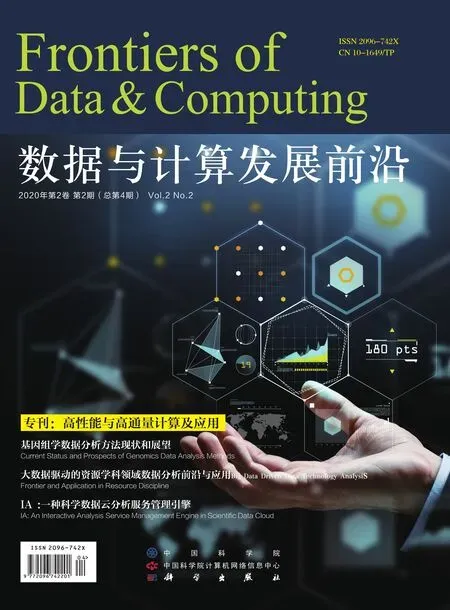Modeling the Effects of Individual and Group Heterogeneity on Multi-Aspect Rating Behavior
Liu Kunpeng,Zhao Xiaosa ,Hu Yirui ,Fu Yanjie *
1.Department of Computer Science,University of Central Florida,Orlando,FL 32816,United States
2.School of Information Science and Technology,Northeast Normal University,Changchun,Jilin 130024,China
3.Population Health Sciences,Geisinger,Danville,PA 17822,United States
Abstract:[Objective] Multi-aspect rating system could help customers better understand the item or service,because it provides not only the overall rating but also more detailed aspect ratings.By modeling the rating patterns on mult i-aspect rating systems,we can better find out latent rating groups and quantitatively understand the rating behaviors lie in these groups.This can also help service provid ers improve their service and attract more targeted customers.However,due to the complex nature of multi-aspect rating system,it is challenging to model its rating pattern s.[Methods] To address this problem,in this paper,we propose a two-step framework to learn the rating patterns from multi-aspect rating systems.Specifically,we first propose a multi-factorization relationship learning (MFRL) method to obtain the user and item aspect factor matrices.In MFRL,we unify matrix factorization,multi-task learning and task relationship learning into one optimization framework.And then,we model the rating patterns by exploiting group-wise overall rating prediction via mixture regression,whose inputs are the factor vectors of users and items learned from MFRL method.[Results]We apply the proposed framework on a real-world dataset (i.e.,the crawled hotel rating dataset from TripAdvisor.com) to evaluate the performance of our proposed method.Extensive experimental results demonstrate the effectiveness of the proposed framework.[Conclusions] Individual and Group Heterogeneity could affect the behaviors behind the rating acts,which should be taken into account in modeling the rating patterns.
Keywords: Multi-Aspect Rating; Recommender System; Multi-Task Learning; Relationship Learning; User Behavior
1 Introduction
Multi-aspect rating system is a popular rating system in many online rating websites.Unlike the traditional rating system which only contains the overall rating,multi-aspect rating system also comprises several aspect ratings.With the help of aspect ratings,multiaspect rating system provides more detailed rating
information thus can better reflect user’s preferences and item’s (e.g.a hotel) attributes.
Modeling the rating patterns on multi-aspect rating system is very important as it takes aspect ratings into account and could produce more accurate recommendations.After analyzing big multi-aspect rating data,we found that user-item pairs can be divided into several groups,where user-item pairs in the same group share the same rating pattern,while user-item pairs from different groups differ in rating patterns.However,most of existing works focus on either the correlations among aspect ratings[1-3]or the relationship between aspect ratings and the overall rating[4-5].Less efforts have been made for capturing the rating heterogeneity in the modeling process.To this end,in this paper,we aim to model the rating patterns on multi-aspect rating system.Along this line,an important objective is to model and predict the overall rating of a given user-item pair.
Intuitively,to predict the overall rating of a given user-item pair,we should firstly obtain representations of the user and the item.To quantify the representations,we intend to simultaneously factorize multiple aspect rating matrices by sharing the latent representation vector of users or items using Collective Matrix Factorization (CoMF)[6-7].However,while CoMF could partially capture the representations of users and items from multiple rating aspects,it could not capture entire representations from the view of correlations between aspect ratings and the overall rating.
All the above pieces of evidence suggest that modeling the rating patterns on multi-aspect rating system is not an easy task.Two unique challenges arise in achieving this goal:
Representation Learning:how to collectively learn the representations of users and items from multiple aspect ratings and overall ratings.
Rating Pattern Modeling:how to capture different rating patterns in user-item pair groups in the process of modeling overall rating from user and item representations.
First,it is revealed by low-dimensional factor models[8-9]that preferences or attitudes of a user are represented by a small number of unobserved factors.Similarly,characteristics or attributes of an item are represented by some other unobserved factors.In a linear factor model,the rating of a user-item pair is modeled by the product of user and item factor vectors.For example,suppose Userihas aD×1 factor vectoruiand Itemjhas aD×1 factor vectorvi,then the rating of Useriover Itemjrijcan be modeled byuT i·vj.More generally,forNusers andMitems,theN×Mrating matrixRis modeled by theD×Nuser factor matrixUand theD×Mitem factor matrixV,i.e.,R=UT·V.
For multi-aspect rating system which has more than one rating,the ratings are modeled in a similar way.The only difference is that the item is not determined by an individual factor vector,rather,each of its aspect has a corresponding factor vector.For example,Userihas aD×1 factor vectoruiwhile aspect 1 and aspect 2 of Itemjhave two correspondingD×1 factor vectorsejandcj,then the rating of Useriover aspect 1 of Itemjgijcan be modeled byand rating of Useriover aspect 2 of Itemjgijcan be modeled byAs Collective Matrix Factorization (CoMF) could simultaneously factorize multiple aspect rating matrices by sharing the factor vector of users or items[6,7,10],it is widely used in multiaspect rating system.However,it does not take the relationship of different aspect ratings into account.From the view of optimization,we regard the factorization of each aspect rating matrix as one task,and how individual aspect ratings affect overall rating as a task relationship regularization term in multi-task learning optimization.In this paper,we unify matrix factorization,multi-task learning and task relationship learning into one optimization framework.Eventually we develop a multi-factorization relationship learning(MFRL) method.
Second,after obtaining the user and item aspect factor matrices,we intend to explore the rating pattern among user-item pairs.Due to the uniqueness of individuals and commonness of groups,it is naturally promising to assume that user-item pairs in the same group share the same rating pattern,while user-item pairs from different groups differ in rating patterns.To characterize these rating patterns,we exploit groupwise overall rating prediction via mixture regression,whose inputs are the factor vectors of users and items learned from MFRL method.Let the rating pattern of a user-item group denote characterized by a parameter vector,the rating pattern is then modeled using the following idea:user- item pairs from the same group will use the same parameter vector to predict overall ratings; user-item pairs from different groups will use different parameter vectors to predict overall ratings.
To summarize,in this paper,we propose a step by step framework to model rating patterns from the multi-aspect rating data.Specifically,the followings are our three main contributions:(1) We propose a multifactorization relationship learning (MFRL) method to simultaneously factorize multiple aspect rating matrices and incorporate the relationship between aspect ratings and the overall rating as a regularization term in the multi-task learning framework.(2)Given the user and item aspect factor matrices,we model the rating patterns among user-item pairs.(3) We apply the proposed framework to explore hotel rating system and predict overall ratings,and the extensive experimental results on real-world hotel rating data demonstrate the effectiveness of our approach.
The rest of paper is structured as follows.Section 2 introduces the relevant problem statement.The proposed two-step model framework for multi-aspect rating system is presented in Section 3.The detail experimental results are presented and discussed in Section 4.Section 5 shows the related work.Finally,Section 5 summarizes the work.
2 Problem statement
In this section,we first introduce some important
definitions as well as the problem statement,and then provide an overview of our proposed model.
Definition 2.1.(Multi-Aspect Rating System)Multi-aspect rating System includes one overall rating and multiple aspect ratings for an item/service.For example,after resting in a hotel,users rate the overall experience together with their ratings on location and cleanliness.The simplest case is one overall rating along with two aspect ratings; the most complex case might be an overall rating along with dozens of aspect ratings.To simplify the modeling of multi-aspect ratings,without loss of generosity,we consider the simplest case in the proposed method,i.e.,one overall rating with two aspect ratings (aspect-1 rating and aspect-2 rating).
Definition 2.2.(Rating Pattern Heterogeneity).In the multi-aspect ratings,there exist multiple latent rating behavior groups,in which user-item pairs in the same group share the same rating pattern,while user-item pairs from different groups differ in rating patterns.For example,as shown in Figure 1,User A and B coupling with Hotel 1,2,3 form six pairs,which are clustered into three rating groups,revealing three different rating patterns correspondingly.
Definition 2.3.(Problem Statement).In this paper,we study the problem of modeling user and item representations as well as group heterogeneity in multiaspect ratings.Letyij,gijandhijbe the overall rating,aspect-1 rating,and aspect-2 rating of userifor itemjrespectively,ui,ejandcjbe the latent representations of thei-th user,the aspect-1 latent representations ofj-th item and the aspect-2 latent representations ofj-th item respectively.Formally,given the historical multiaspect rating records {<yij,gij,hij> |i∈[1,I],j∈[1,J]},our objective is to find a mapping function that takes a new user IDi*and a new item IDj*as inputs,and accurately outputs the overall ratingaspect-1 ratingaspect-2 ratingvia effectively modeling representations and rating pattern heterogeneity.
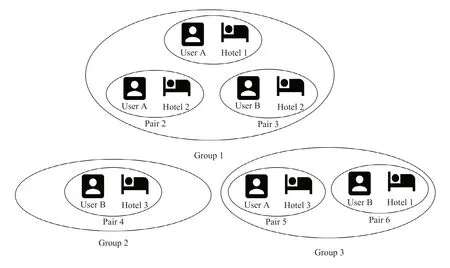
Fig.1 Pair rating groups
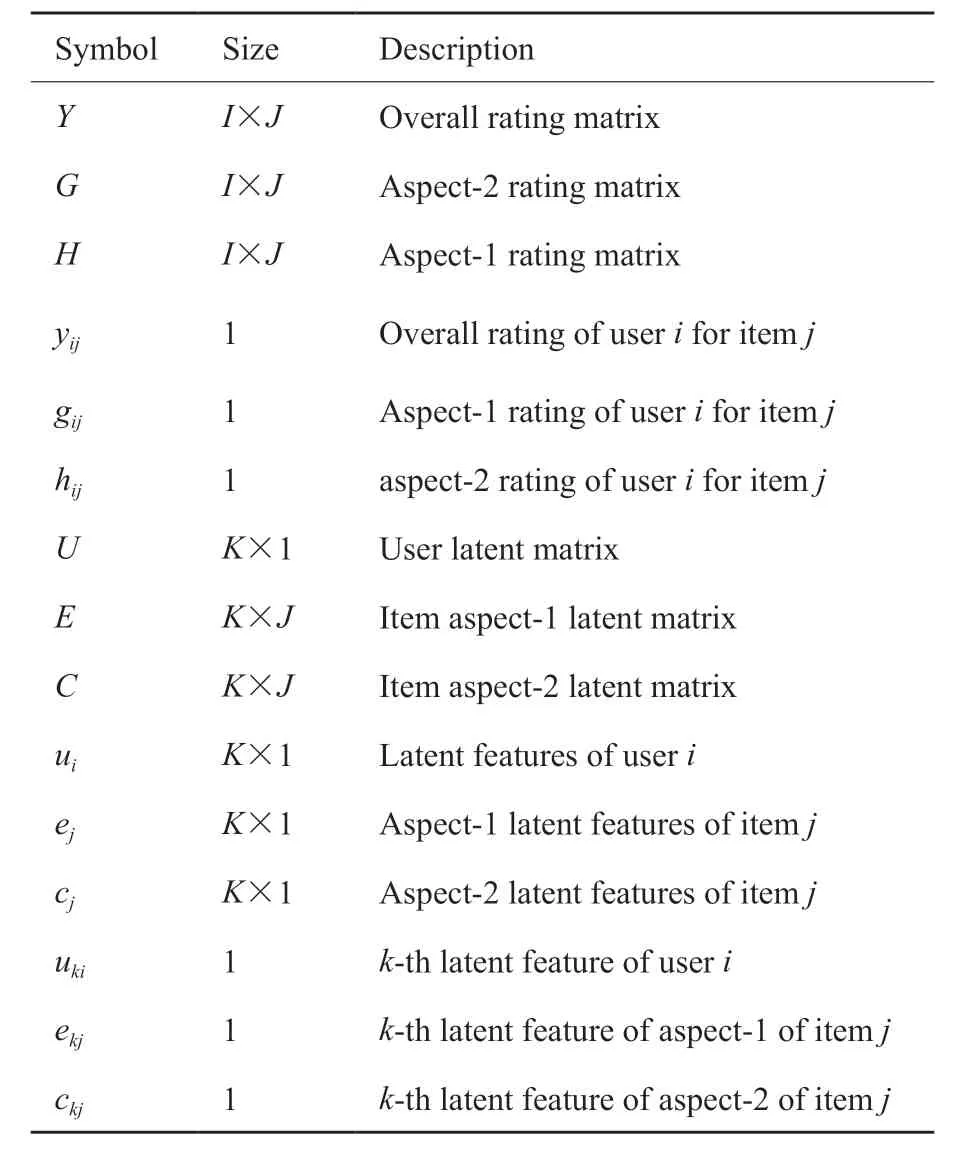
Table1 Mathematical notations
2.1 Framework Overview
Figure 2 shows the framework overview of our proposed method.This framework consists of two major stages.
(1)Modeling of the Generative Process.We propose to model the individual heterogeneity in multiaspect rating behavior by combining multi-factorization learning and factorization relationship learning.The multi-factorization learning is to model the individual differences in preferences for aspect-1 and aspect-2 ratings; the factorization relationship learning is to model the individual differences in preferences for the relationship between the overall ratings and the aspect-1 and aspect-2 ratings.Figure 3 shows the graphical model of generating overall,aspect-1,and aspect-2 ratings.
Specifically,we first draw the user latent featuresui.The aspect-1 ratinggijis generated by the interaction between user latent featuresuiand aspect-1 latent featuresej.Similarly,the aspect 2 ratinghijis generated by the interaction between user latent featuresuiand item aspect-2 latent featurescj.The overall rating is generated by the parameterized aspect ratings.Therefore,the aspect-1 rating isgij∝uT iej,the aspect-2 rating ishij∝uT icj,and the overall rating is

Wherepandqare constant weights.Table2 summarizes the multi-aspect rating behavior of how userirates itemj.
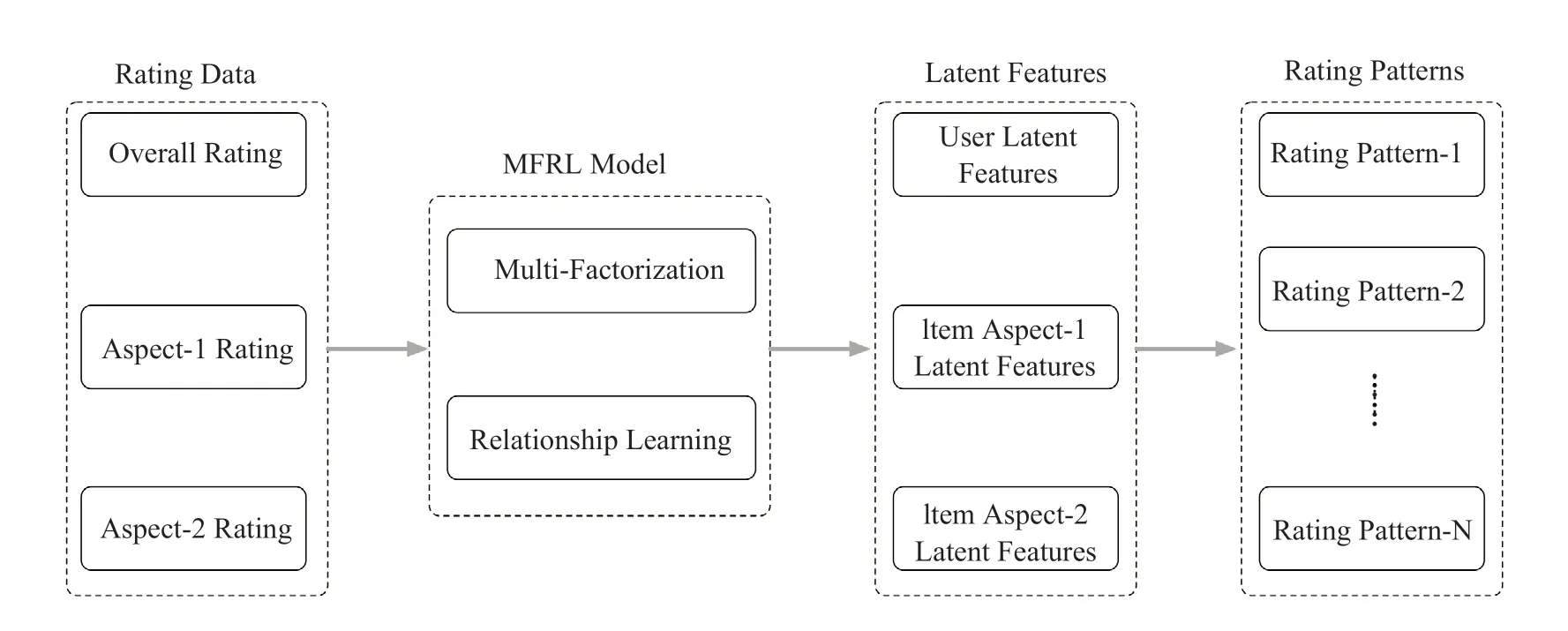
Fig.2 Framework overview
(2) Modeling of the Rating Pattern Heterogeneity.After modeling the generative process,we obtain the latent features of users,item aspect-1,and item aspect-2,respectively denoted byIn the rating pattern heterogeneity,we assume there areNlatent groups in the rating behavior.Each group has a unique rating pattern,which exhibits a unique relationship between overall rating and the latent features of user-item pairs in the same group.Consequently,the overall ratings can be regarded as the mixture overall ratings generated byNgroups.
Wherey(n)ijis the overall rating of thei-th user and thej-th item in then-th group,andf(n)is the mapping function from the latent features of thei-th user and thej-th item to the overall rating.
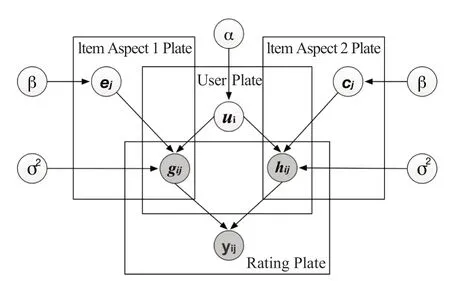
Fig.3 The framework overview and the proposed MFRL Model
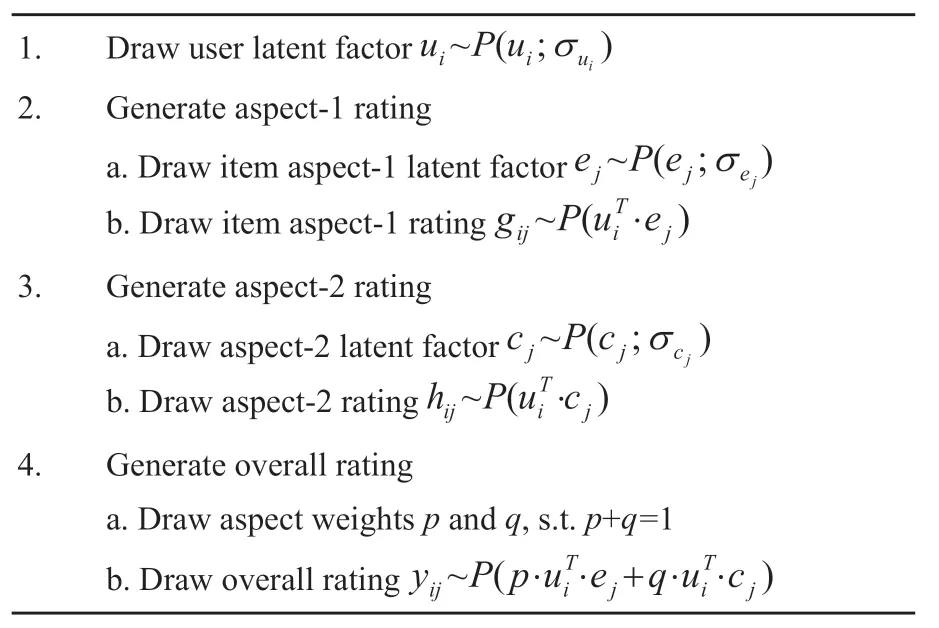
Table2 The generative process
3 Proposed method
We first introduce how to model the generative process in multi-aspect rating behavior,and then develop a multi-factorization relationship learning method.Later,we extend the multi-factorization relationship learning method by integrating the modeling of rating pattern heterogeneity via group-wise mixture regression.
3.1 Model Intuitions
There are individual preferences as well as rating pattern heterogeneities among multi-aspect rating behavior.Therefore,in our approach,we model the generative mechanism of multi-aspect ratings based on the following three intuitions.
Intuition 1:We assume aspect ratings are generated by the interaction between user latent features and item aspect features,thus we can infer user latent features and item aspect latent features from the aspectrating factorizations.For example,cleanliness rating of a hotel can be generated by user latent features and cleanliness latent features,thus we can infer user latent features and cleanliness latent features from cleanliness ratings.Since there are multiple aspect ratings,we combine both multi-task learning and matrix factorization to develop a multi-task factorization method,in order to simultaneously factorize aspect rating matrices to learn user latent vectors and multiple item-aspect latent vectors.
Intuition 2:The overall rating has strong correlations with aspect ratings,which could connect user and aspect latent features with the overall rating.For example,the overall rating of a hotel can be predicted by its cleanliness rating and location rating,while these two aspect ratings can be predicted by their corresponding user and aspect latent features.Consequently,to improve the accuracy of overall rating prediction,we incorporate the relationship between aspect ratings and overall ratings into the multi-task factorization method,so as to simultaneously factorize aspect ratings while learning the overall-aspect rating relationship.We call the method multi-factorization relationship learning (MFRL).
Intuition 3:There are different latent groups of user-item pairs,where each group exhibits a unique rating pattern.We integrate the group-wise mixture regression model that takes the user latent features and item-aspect latent features as inputs.The group-wise mixture regression model can exploit the reinforcement of clustering user-item pairs and predicting user-item overall ratings.That is,suppose the unknown rating pattern is characterized as ab-dimensional coefficient vectorin a linear system.LetXbe thea×bfeature matrix of the user-item pairs in the group,Ybe thea-sized overall ratings of the user-item pairs in the group.We can obtainY=X·that shows how the useritem pairs in the same group share the same rating pattern mathematically in regressions.
3.2 Multi-Task Matrix Factorization
Matrix Factorization based methods have been widely used to analyze users’ rating behavior.Probabilistic Matrix Factorization (PMF)[9]is one of the matrix factorization based methods that can be applied for single aspect rating.Considering the simplest triple case:[user,item,aspect-1 rating],where aspect-1 rating of thei-th user for thej-th item isgij,the aspect-1 ratinggijcan be factorized withuiandej,which represent the user latent features and item aspect-1 latent features respectively.uiandejencode the affinity of thei-th user and the aspect-1 of thej-th item in the latent space.In single rating matrix factorization,we place exponential distribution onukjandekjas the empirical prior,and an inverse gamma distribution on.Then we assume the ratinggijis drawn from normal distributions with the meanand the variance.The generative process ofgijfollows:[1][2]DrawDrawGenerate
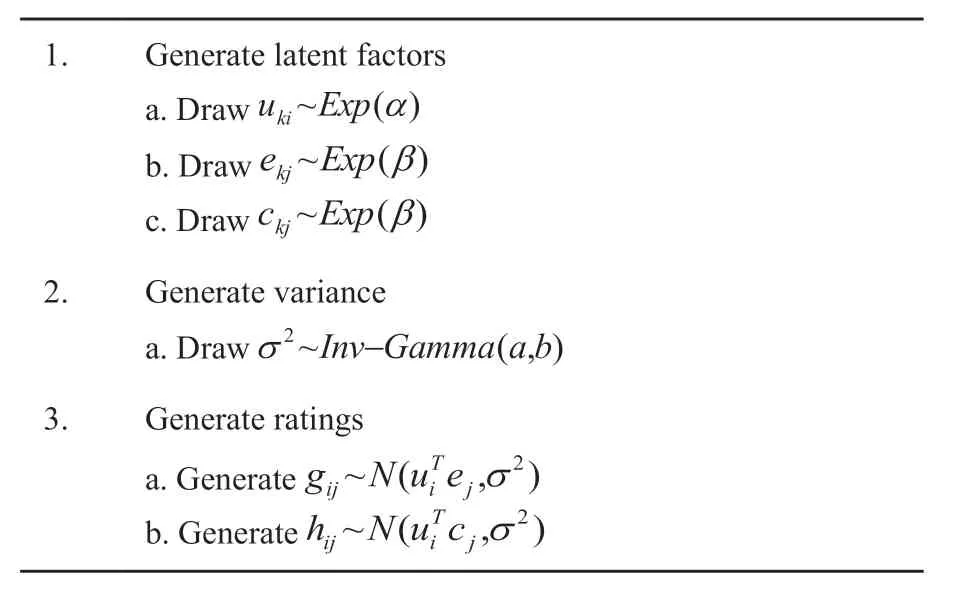
Table3 The generative process of MTMF
Unlike single rating systems,in our multi-aspect rating problem,we have multiple ratings given by individual user for each item.Let us consider the four-tuple rating case:[user,item,aspect-1 rating,aspect-2 rating].Figure 3 shows that the interaction between user plate and aspect-1 plate generates the aspect-1 ratinggij,and similarly the interaction between the user plate and aspect-2 plate generates the aspect-2 ratinghij.Table3 shows that the two aspect ratings share the same user latent features.By regarding the factorization of each aspect rating matrix as one task,we develop a Multi-Task Matrix Factorization(MTMF) to co-factorize the rating triplet via maximizing the likelihood of the observed aspect ratings.
3.3 Multi-Factorization Relationship Learning
We identify that overall rating has strong correlations with aspect ratings,and thus propose to incorporate the overall-aspect rating relationship learning into the multitask learning.
Let us consider the five-tuple rating case:[user,item,overall rating,aspect-1 rating,aspect-2 rating].Be sure to notice that the interaction between the aspect-1 ratinggijand the aspect-2 ratinghijgenerates the overall ratingyij,while the aspect-1 ratinggijis drawn fromuT iej,and the aspect-2 ratinghijis drawn fromuT icj.We assume the ratingyijis drawn from the normal distributions with the meanand varianceThe generative process ofyijfollows:[1]DrawDraw[3]Draw[4]Draw[5]Generate[6]Generate[7]Generate
As a result,we take into account the relationship between the overall ratings and the aspect ratings.Table4 shows the Multi-Factorization Relationship Learning(MFRL) is a uniform three layer hierarchical framework.From top to bottom,the first layer specifies how to generate a rating triplet in terms of the overall,aspect-1 and aspect-2 utilities that thei-th user obtains from thej- th item.The second layer describes how to extract the overall,aspect-1 and aspect-2 utilities.Finally,the third layer presents all the latent factors and the variance.
3.4 Parameter Estimation in MFRL
We denote all the parameters bythe observed dataset byand the hyper-parameters byGivenDandour goal is to find the parametersthat maximize the posterior probability

According to Table4,G,H,Yare generated by:

Table4 MFRL:a hierarchical view
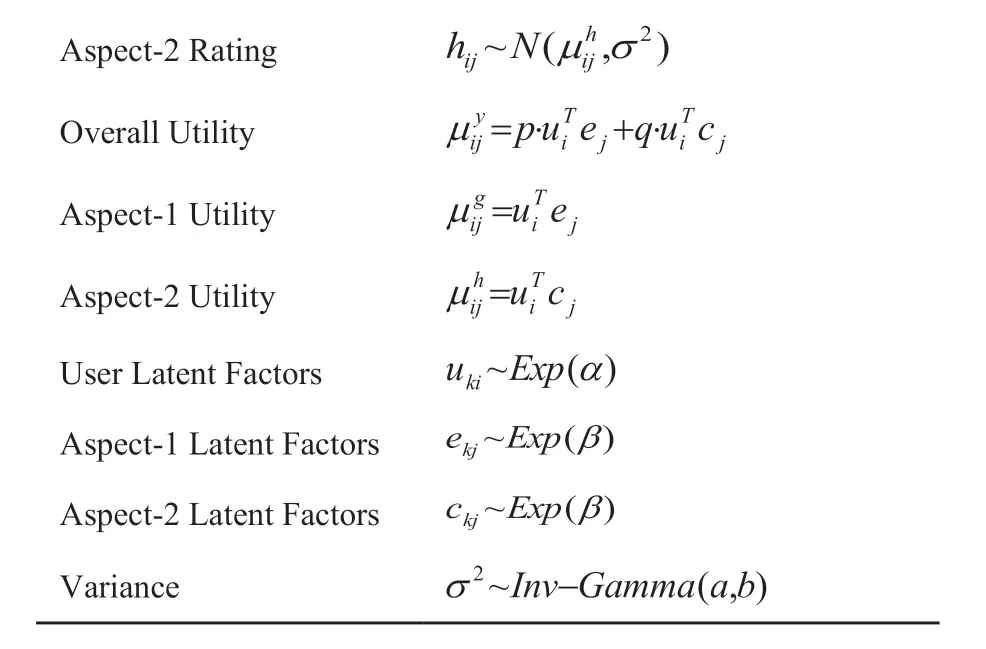
Aspect-2 Rating Overall Utility images/BZ_70_1824_505_1843_525.pngAspect-1 Utility Aspect-2 Utility User Latent Factors Aspect-1 Latent Factors Aspect-2 Latent Factors Variance
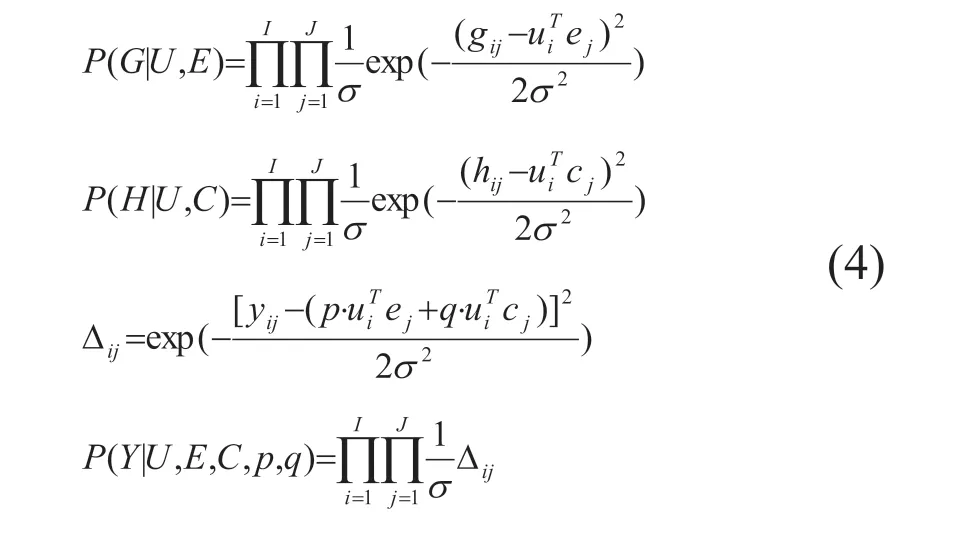
Where Δ1is the posterior of overall rating generated by Useriand Itemj.
What’s more,we draw the elements inU,E,Cfrom exponential distributions:
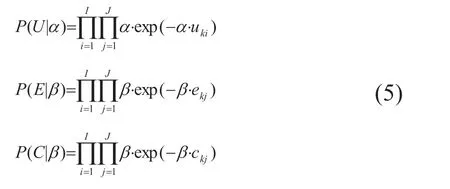
In addition,we draw the variancefromdistribution:

Eventually we get the log of posterior for the MFRL model by Eq.7.For simplicity,letandWe apply Iterated Conditional Modes(ICM)[11]method and obtain the updating rules for the parameters inby Eq.8.
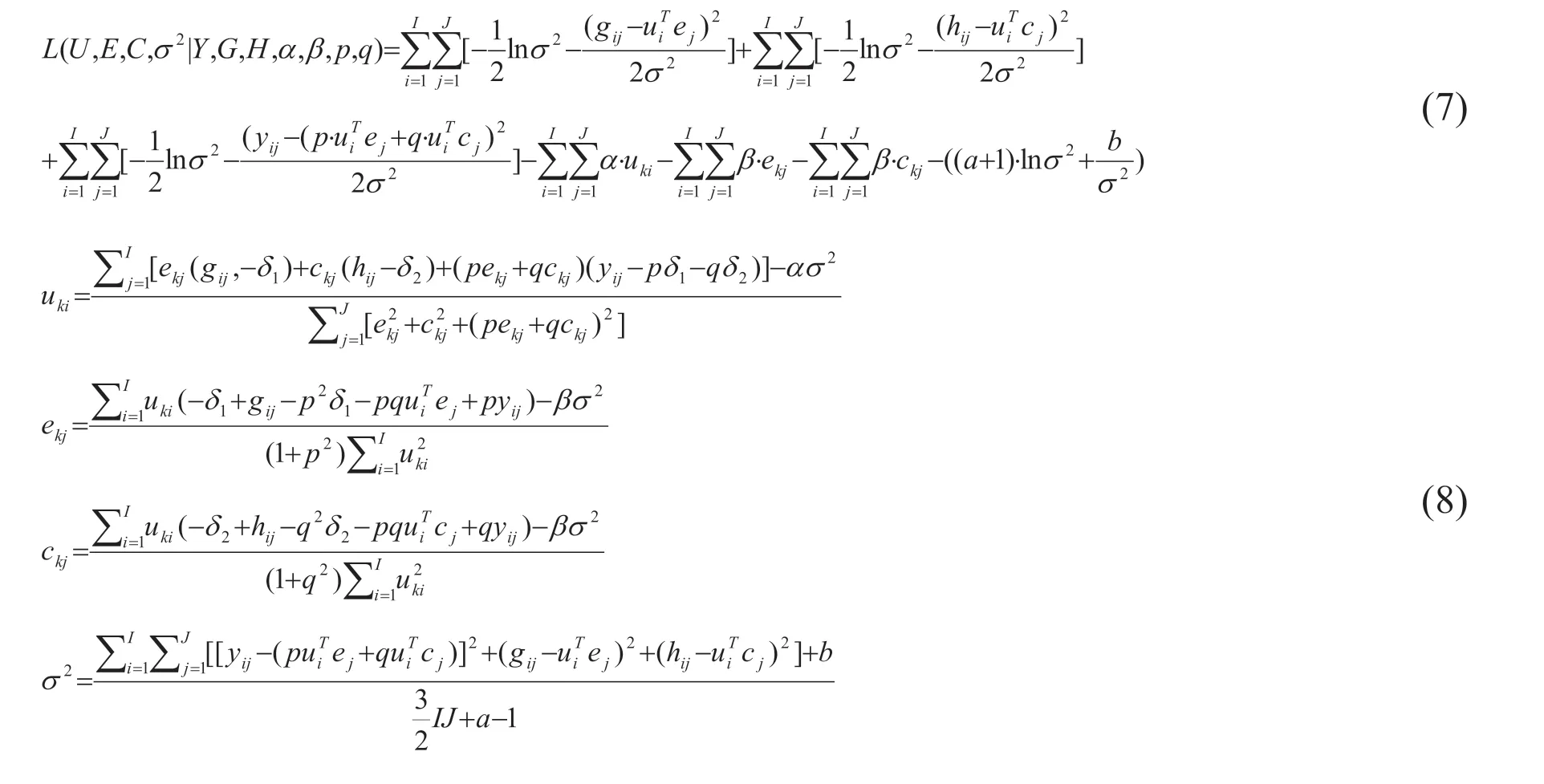
3.5 Incorporating Group Heterogeneity
To incorporate the group heterogeneity in the modeling of multi-aspect rating behavior,we combine group-wise mixture regression into the Multi-Factorization Relationship Learning (MFRL) and develop the framework of Mix-MFRL.
Considering a rating triple:[user,item,overall rating].With the Multi-Factorization Relationship Learning(MFRL),we use the obtained user latent featuresuito represent thei-th user.We use the obtained item latent aspect featuresej,cjto represent the aspect-1 and aspect-2 of thej-th item.We assume there areNrating groups for the rating pairs (yij,[ui,ej,cj]).For then-th rating group,we use a regression method to model the correlation betweenyijandTable5 shows the overall rating predictions that are based on group-wise mixture regressions.
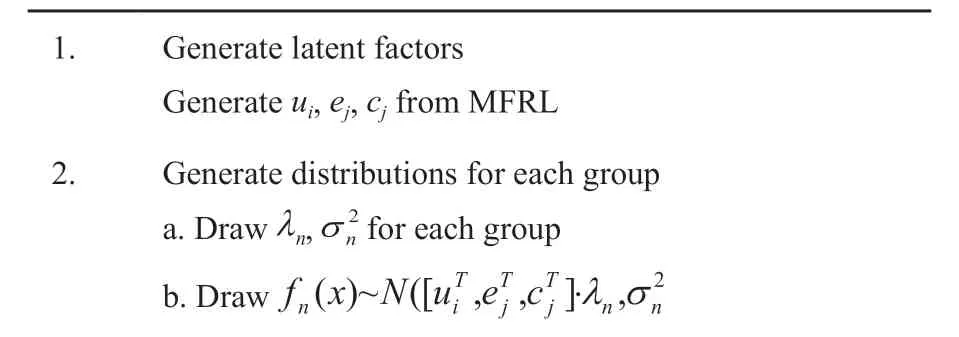
Table5 The generative process of Mix-MTMF

3.Generate overall rating b.Generate weight in the mixture model c.Generate
3.6 Parameter Estimation of Mix-MFRL
We denote all the parameters bythe concatenation of latent vectorsand the rating pairsGivenR,our goal is to find the parametersthat maximize the likelihood probabilityAccording to Table5:

We apply Expectation Maximization (EM)[12]algorithm to optimize Equation 9.Specifically,we introduce latent variableswhere eachzijindicates which group the rating pairrijbelongs to.In the (g+1)-th iteration,we first get the expectation of likelihood in E-step based on the parameters derived fromg-th iteration and then obtain the (g+1)-th optimized parameters through the maximization of expectation of likelihood in M-step.
In E-step of (g+1)-th iteration,the expectation of likelihood:

where,
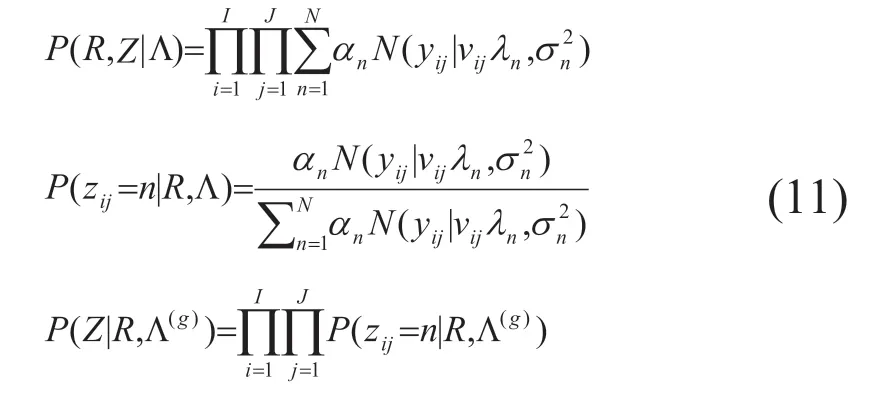
We conduct the integration operation and then obtain:
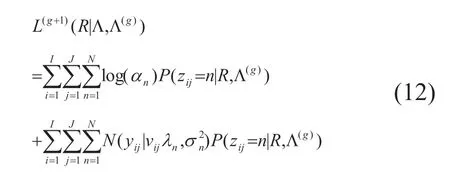
In M-step,we maximize the expectation of likelihood overand obtain the (g+1)-th optimized parameters:

4 EXPERIMENTAL RESULTS
We evaluate the proposed model with real-world data in terms of various tasks.
4.1 Data Description
We crawled the experiment data set from the website of‘ TripAdvisor.com’ which provides hotel and restaurant reviews and ratings.The dataset comprises 191 192 ratings from 132 215 users for 1 800 hotels.The rating values range from 1 to 5,where 1 indicates that the user does not like the hotel,and 5 denotes a high preference.In this dataset,the number of users who rate more than 1,2,3 times are 17 904,4 911 and 1 787 respectively,which means most users only rate onc and thus the dataset is very sparse.In addition,besides the overall rating,there are six aspect ratings:value,rooms,location,cleanliness,sleep quality and service.We select two of them,i.e.,cleanliness rating and location rating by Chi-Square feature selection[13].
4.2 Evaluation Metrics
Prediction Accuracy:We will evaluate the model with Mean Absolute Error (MAE) and Root Mean Square Error (RMSE) defined as follows:

Whereyijdenotes the observed overall rating anddenotes the predicted overall rating.The smaller the value of MAE and MSE,the more accurate the modeling.
Top-M Recommendation:We also evaluate the algorithms in terms of ranking performance.We provide each user with two groups of M hotels sorted by their predicted overall ratings and observed overall ratings respectively.And then we evaluate the ranking accuracy based on Normalized Discounted Cumulative Gain(NDCG).The Discounted Cumulative Gain (DCG@M) metric assumes that highly rated hotel should appear earlier in the recommendation list of the length M.The DCG@M from predicted ratings can be represented as:

Also,the Ideal Discounted Cumulative Gain(IDCG) from observed ratings can be represented as:

Then,NDCG@M can be formulated as
4.3 Baseline Algorithms
Since our work is related to Matrix Factorization(MF) and clustering,we compared our method with the following algorithms.(1) Probabilistic Matrix Factorization (PMF)[9]:factorizes overall rating matrix.(2) Bayesian Co-Nonnegative Matrix Factorization(BCoNMF)[14]:co-factorizes overall matrix with the aspect rating matrix.(3) Multi-task Learning (MTL)[15]:factorizes overall rating matrix and the aspect rating matrix independently and optimize them simultaneously.(4) Hierarchical Model (HM)[16]:firstly clusters latent vectors,and then learns the model of each cluster independently,at last combine each cluster model together.
4.4 Study of Latent Group Number
At first stage,we try to figure out the most appropriate number of latent group in Mix-MFRL,thus we explore the performance of Mix-MFRL with latent group number N = 1,2,...,10 respectively.Since we also need the hyper-parameter K in the experiment,which denotes the latent dimension in matrix factorization,we compare the performances of Mix-MFRL with different latent dimension K (K = 2,5,10,20 respectively) for each N.
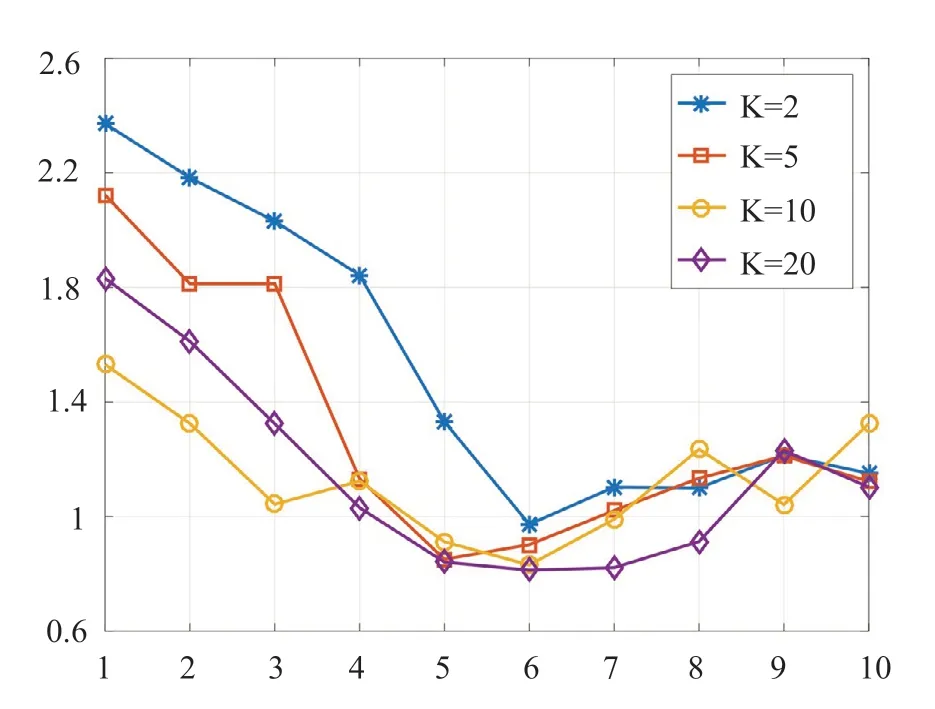
Fig.4 MAE performances of Mix-MFRL at different latent group numbers
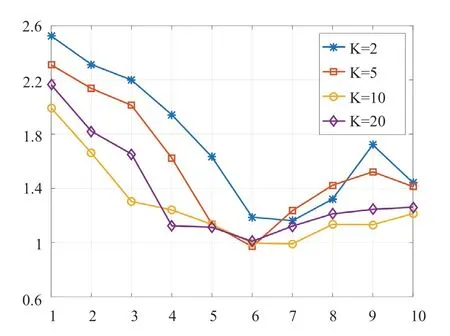
Fig.5 RMSE performances of Mix-MFRL at different latent group numbers
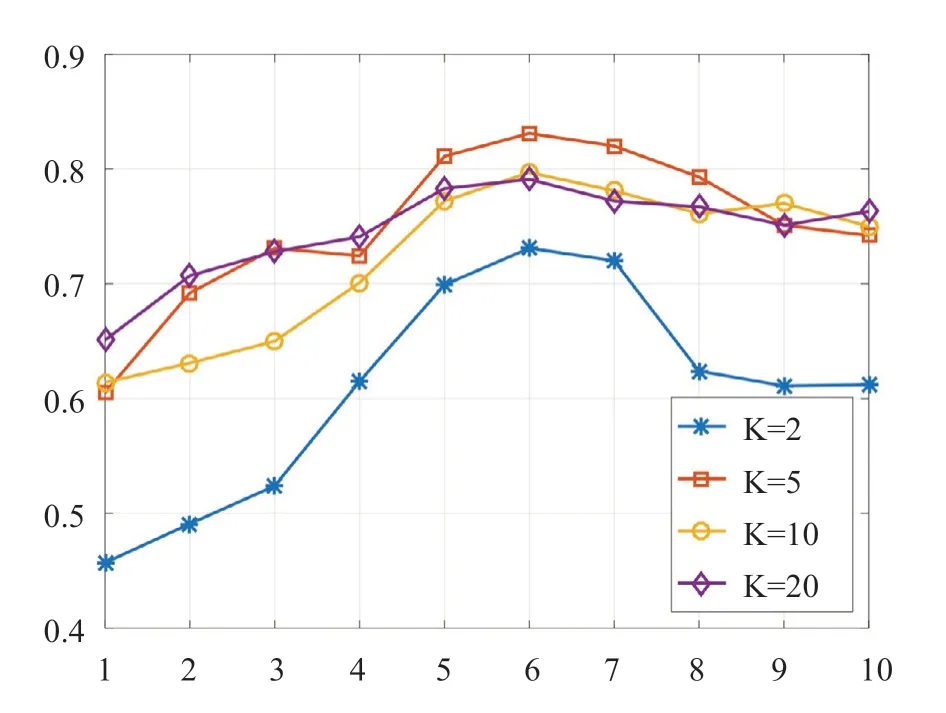
Fig.6 NDCG_3 performances of Mix-MFRL at different latent group numbers
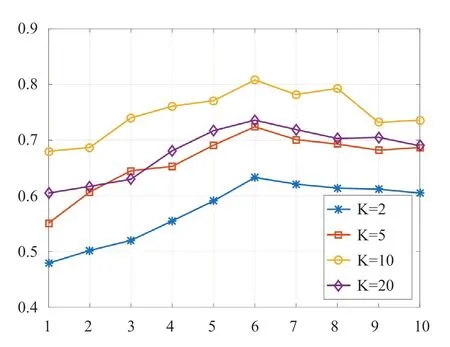
Fig.7 NDCG_5 performances of Mix-MFRL at different latent group numbers
As we can see from Figure 4,5,6,7,for all evaluation metrics,with N increasing from 1 to 6,the performances improve monotonously,while with N increasing continuously,the performances drop gradually.We then infer that N = 6 is the best latent group number for our dataset.In the following experiment,we will fix N = 6.
4.5 Overall Performances
Here,we present the performance comparison on overall rating in terms of accuracy and top-M recommendation.
Prediction Accuracy.We compare our method with baseline methods in terms of MAE and RMSE,with latent dimensions K = 2,5,10,20 respectively.The MAE comparisons are shown in Figure 8.Overall,MFRL outperforms baselines with significant margins and Mix-MFRL further improves the performance of MFRL.In addition,in all the baselines,BCoNMF and MTL work slightly better than PMF and HM in all K value settings.Figure 9 shows the RMSE comparisons:MFRL outperforms all the competing models and Mix-MFRL improves MFRL.

Fig.8 The MAE values at different latent dimensions

Fig.9 The RMSE values at different latent dimensions
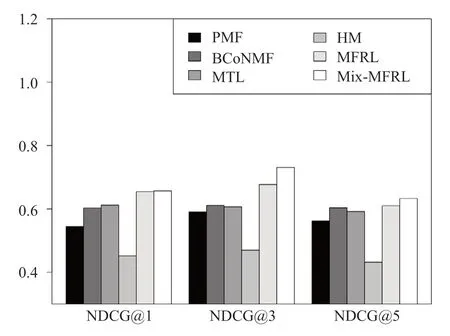
Fig.10 NDCG at different latent dimensions 2
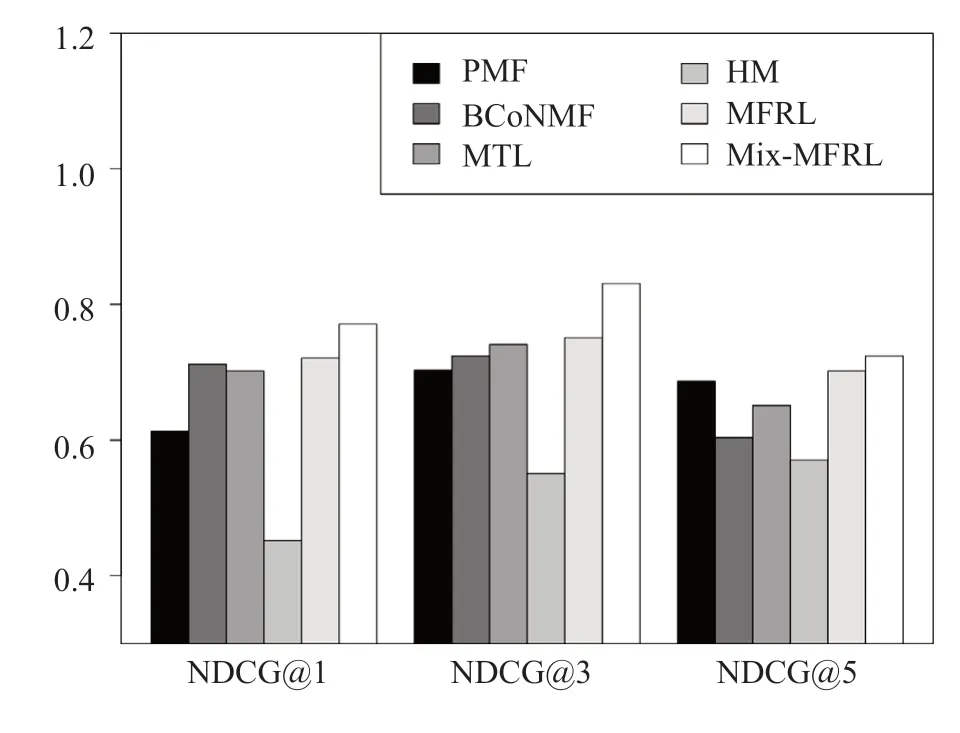
Fig.11 NDCG at different latent dimensions 5
Top-M Recommendation.Figure 10,11,12,13 show the top-M recommendation performances of MFRL and Mix-MFRL with four baselines in terms of NDCG@M (M = 1,3,5 respectively).In the experiment,we choose those who rate more than M hotels.Then,we apply all the six methods to recommend an M-length hotel list to those users and calculate the NDCG@M of the Top-M recommendation against its ground truth.We can see from Figure 10-13 that MFRL and Mix-MFRL still achieve the best results with list length M = 1,3,5 and latent dimension K = 2,5,10,20.
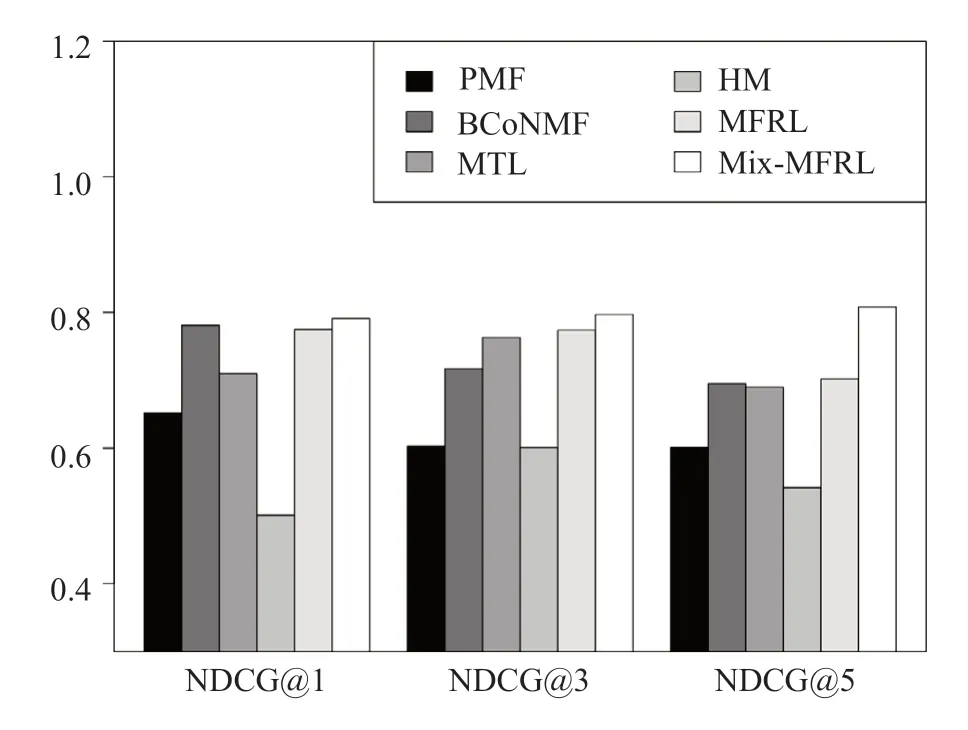
Fig.12 NDCG at different latent dimensions 10
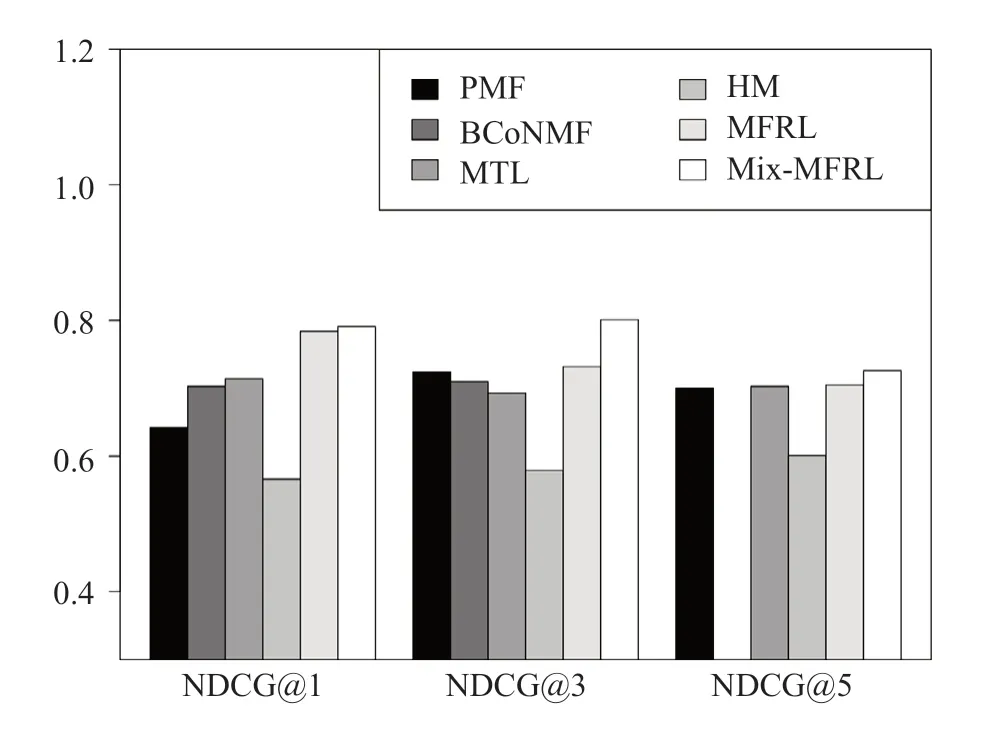
Fig.13 NDCG at different latent dimensions 20
4.6 Study of Aspect Rating Prediction
Besides overall ratings,we evaluate the prediction accuracy of location ratings and cleanliness ratings and check if the proposed model can correctly capture the aspect ratings.There are no latent groups in the prediction of aspect ratings,thus there is no need for clustering.Without clustering,Mix-MFRL degenerates to MFRL and HM is no longer qualified as a baseline.We then compare PMF,BCoNMF,MTL and MFRL in the prediction of aspect ratings.Figure 14 and Figure 15 report the MAEs and RMSEs of location rating prediction of MFRL comparing with other three baselines,where we can see significant advantage of MFRL over baselines.Similarly,in the MAEs and RMSEs of cleanliness ratings,RMFL is better than baselines with significant margins as shown in Figure 16 and Figure 17.The consistent high accuracy in both location and cleanliness ratings proves the correctness of jointly factorizing the overall and aspect ratings.
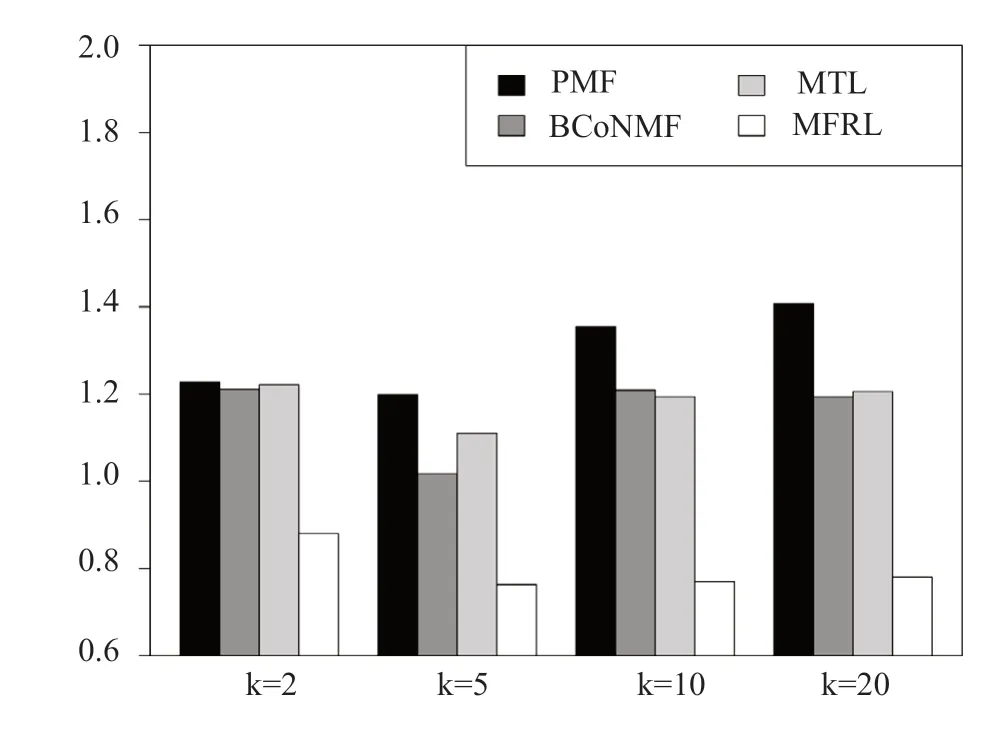
Fig.14 MAE of location rating
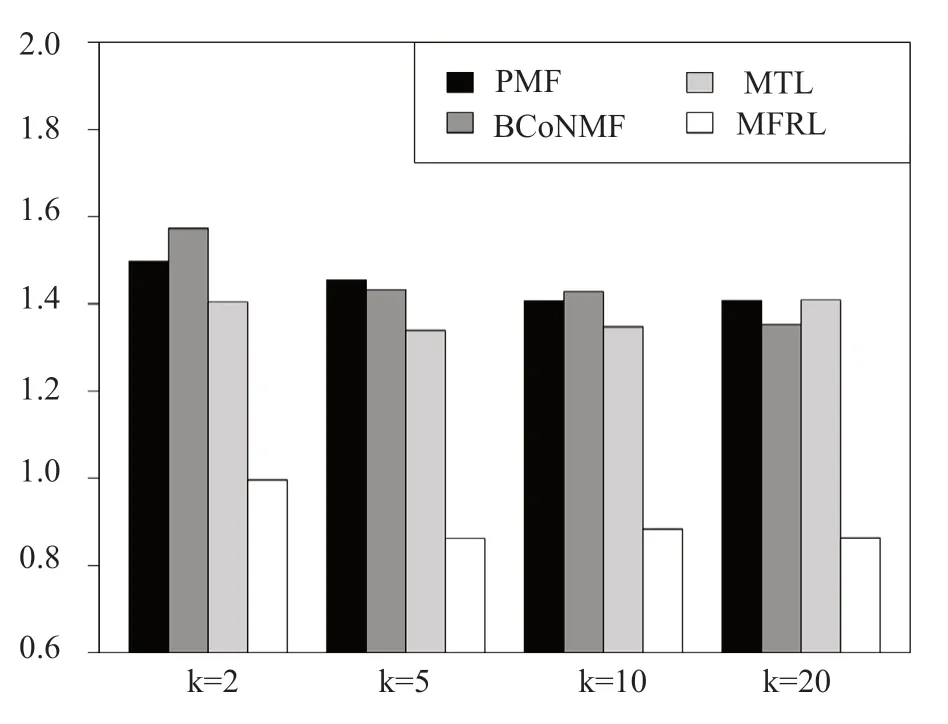
Fig.15 RMSE of location rating
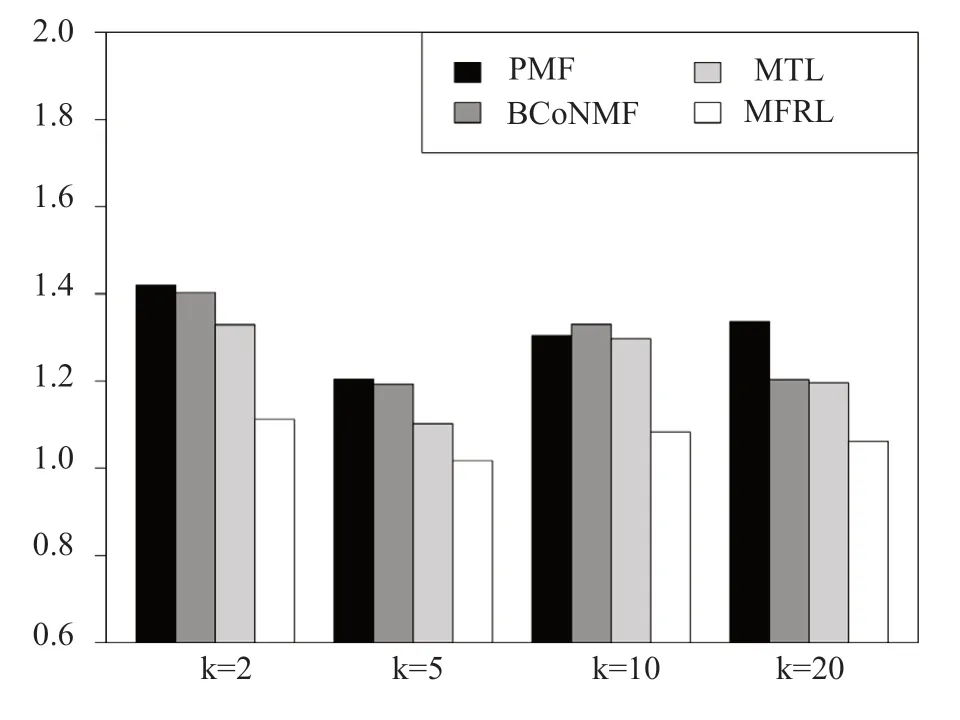
Fig.16 MAE of cleanliness rating
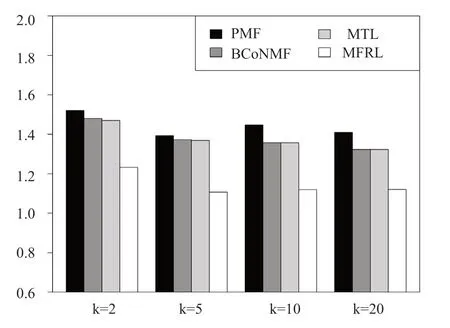
Fig.17 RMSE of cleanliness rating
4.7 Robustness Check
We fix N = 6 to carry out the robustness check of proposed models with K = 5 and K = 20 respectively.We use 5-fold cross validation,where we partition the entire dataset into 5 complementary subsets.The cross validation of dataset consists 5 rounds,each of which involves training the model on 4 subsets and validating the performance on the remaining subset.From Table6,we can see both MFRL and Mix-MFRL perform steady without significant fluctuations in different rounds.In Table6,we denote round cross validation asRi(i=1,2,3,4,5).

Table6 Performance of MFRL and Mix-MFRL in 5-fold cross validation
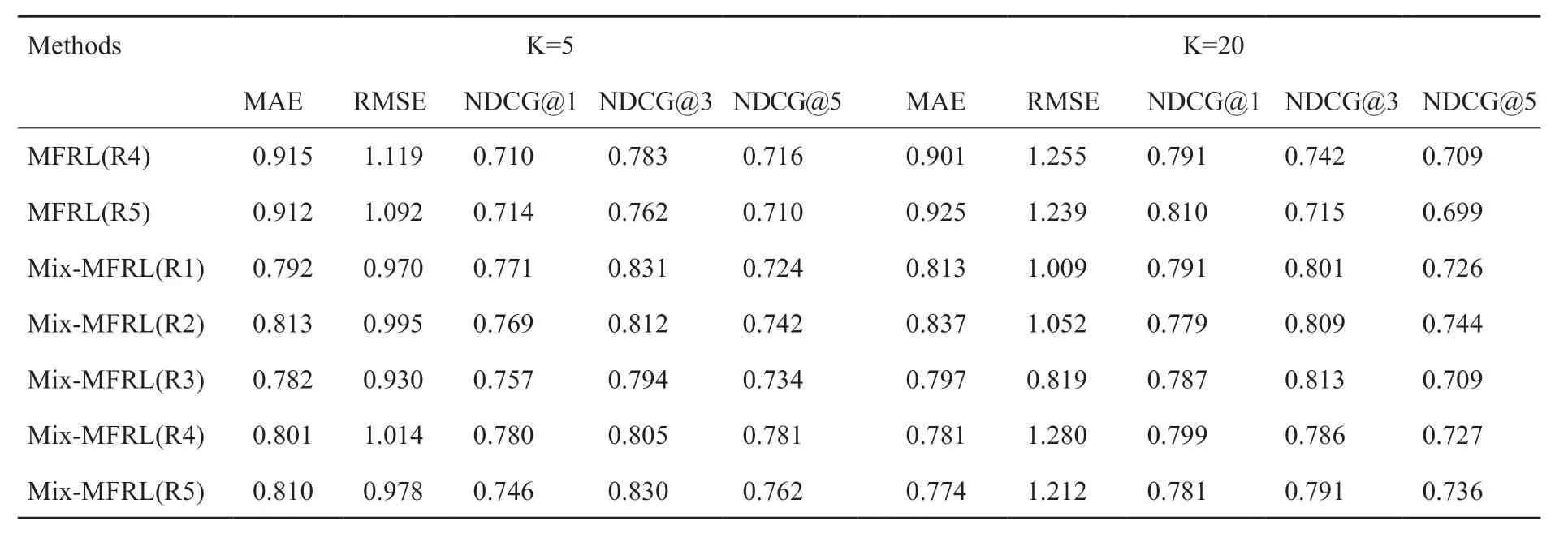
Methods K=5 K=20 MAE RMSE NDCG@1 NDCG@3 NDCG@5 MAE RMSE NDCG@1 NDCG@3 NDCG@5 MFRL(R4) 0.915 1.119 0.710 0.783 0.716 0.901 1.255 0.791 0.742 0.709 MFRL(R5) 0.912 1.092 0.714 0.762 0.710 0.925 1.239 0.810 0.715 0.699 Mix-MFRL(R1) 0.792 0.970 0.771 0.831 0.724 0.813 1.009 0.791 0.801 0.726 Mix-MFRL(R2) 0.813 0.995 0.769 0.812 0.742 0.837 1.052 0.779 0.809 0.744 Mix-MFRL(R3) 0.782 0.930 0.757 0.794 0.734 0.797 0.819 0.787 0.813 0.709 Mix-MFRL(R4) 0.801 1.014 0.780 0.805 0.781 0.781 1.280 0.799 0.786 0.727 Mix-MFRL(R5) 0.810 0.978 0.746 0.830 0.762 0.774 1.212 0.781 0.791 0.736
5 RELATED WORK
Related work can be grouped into (i) recommendations in multi-aspect rating systems,(ii) multi-task learning and relational regularization,(iii) collective factorization and finite mixture models,and (iv) user heterogeneity in economics.
Modeling Multi-Aspect Rating Data.Our work is related to the studies of modeling multi-aspect rating data.For example,Lee et al.[17]reduced the problem to a multiple criteria ranking task and applied an adapted skyline query algorithm.Adomavicius et al.[18]extended the single criteria CF to include multi-criteria ratings in the calculation of the similarity between users or items by applying average similarity or worst-case similarity schema.Also,Adomavicius et al.proposed to use standard CF to predict single criteria rating,then a weighted linear regression function was applied to aggregate multiple criteria ratings to a global rating[19].Singh et al.proposed to view rating matrix as a pairwise relationship between two participants and simultaneously factorized multiple rating matrices into latent space[10].Singh et al.formulated the generic problem of collective factorization,but only provided the model inference for co-factorizing two rating matricesU×V→R1,V×I→×R2.Baas et al.proposed a framework to deal with multiple-alternative decision problems under the assumption that all the alternatives in the choice set could be characterized by a number of aspects and that information was available to assign weights to these aspects and to construct a rating scheme for the various aspects of each alternative[4].Liuet al.proposed a destination prediction framework via multiview spatiotemporal data[39].Zhu et al.proposed an aspect-based segmentation algorithm to first segment a user review into multiple single-aspect textual parts,and an aspect-augmentation approach to generate the aspectspecific feature vector of each aspect for aspect-based rating inference[3].
Multi-task learning with task-relation regularization.The framework of this paper is inspired by the idea of multi-task learning.Argyriou et al.presented a method for learning a low-dimensional representation which was shared across a set of multiple related tasks[20].Jalali et al.considered the multiple linear regression problem in a setting where some of the set of relevant features could be shared across the tasks[21].Lounici et al.studied the problem of estimating multiple linear regression equations for both prediction and variable selection[22].Liu et al.proposed two frameworks to capture the relationship between different agents in the learning process[40-41].Zhou et al.proposed a multitask learning formulation for predicting the disease progression measured by the cognitive scores and selecting markers predictive of the progression[23].Kumar et al.proposed a framework for multi-task learning that enabled one to selectively share the information across the tasks[24].Evgenioumodeled the relation between tasks in terms of a novel kernel function that used a taskcoupling parameter[25].Liu et al.proposed to accelerate the computation by reformulating the optimization problem as two equivalent smooth convex optimization problems which were then solved via the Nesterov’s method[26].Zhang et al.proposed a regularization formulation for learning the relationships between tasks in multi-task learning[27].Xue et al.developed computationally efficient algorithms for two different forms of the multi-task learning problem relying on a Dirichlet process based model to learn the extent of similarity between classification tasks[28].
Finite Mixture Models.Moreover,our work also has a connection with finite mixture models.Figueiredoproposed an unsupervised algorithm for learning a finite mixture model from multivariate data which seamlessly integrated estimation and model selection in a single algorithm[29].Zivkovic et al.proposed a recursive algorithm that estimated the parameters of the mixture and that simultaneously selected the number of components[30].Chenproposed a modified likelihood ratio test for homogeneity in finite mixture models with a general parametric kernel distribution family[31].Bapna et al.simultaneously classified firms into homogeneous segments based on firm-specific characteristics and estimated the model’s coefficients relating predictor variables to electronic payments systems adoption decisions for each respective segment[32].MuthÃľn et al.discussed the analysis of an extended finite mixture model where the latent classes corresponding to the mixture components for one set of observed variables influenced the second set of observed variables[33].Yu et al.proposed a multi-mode process monitoring approach based on finite Gaussian mixture model and Bayesian inference strategy[34].
User Heterogeneity.User Heterogeneity is a nontrivial factor in the proposed CMRL model,which is also a big topic in economics and market.Teratanavat et al.presented a research technique exploring differences in consumer preferences and valuations for a novel functional food products[35].Cicia et al.investigated the preferences of an important category of consumers of organic products allowing for preference heterogeneity[36].Dhar et al.found out that the decision to defer choice was influenced by the absolute difference in attractiveness among the alternatives provided and was not consistent with trade-off difficulty or the theory of search[37].Kamakura et al.developed a choice model that simultaneously identified consumer segments on the basis of their preferences,response to the marketing mix,and choice processes[38].Breffle et al.investigated several different parametric methods to incorporate heterogeneity in the context of a repeated discrete-choice model[42].Cutler et al.presented empirical evidence in five difference insurance markets in the United States that was consistent with this potential role for risk tolerance.Poulsen et al.presented a new model that combined latent class regression analysis with random coefficient regression models together with principal components regression[43].
6 CONCLUSION REMARKS
User heterogeneity is widely observed in users’rating behavior.In this study,we identified the rating pattern heterogeneity after learning the latent features of users and items.We find that it is essential to jointly model the generative process of rating as well as the rating pattern heterogeneity for understanding users’multi-aspect rating behavior.Along this line,we first developed a multi-factorization relationship learning method to model the generative process in multiaspect rating.Later,we developed an extended method by integrating group-wise mixture regression method to model the effects of rating pattern heterogeneity.Finally,we presented extensive experiments on the realworld multi-aspect rating data of TripAdvisor.com to demonstrate the effectiveness of the proposed methods.

